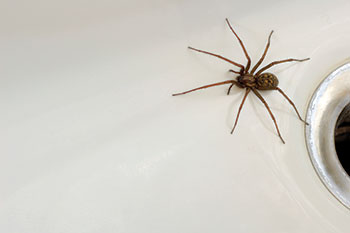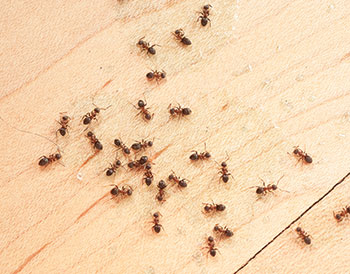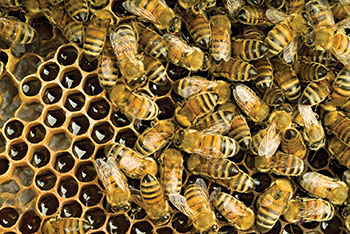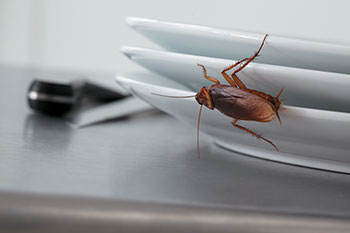Read more about ants, spiders and other pests
ANTS: The Damage & the Danger
In spite of their small size, different varieties of ants can cause significant types of damage. For example, carpenter ants tunnel through wood, destroying structures as thoroughly as termites do. Pharaoh ants are known for transmitting serious diseases. The increasingly common fire ant’s sting is potentially deadly to susceptible individuals. Whatever the type, all ants contaminate any food that they infest.
Detection & Treatment
Ants tend to build massive colonies, so their presence is easily detected when you see either their nests or the ants themselves. Proven Antimite treatments include special baiting, insecticides and sealing off common entry points to buildings.

SPIDERS: The Damage & the Danger
Spiders let themselves into your home through its windows and doors. Often, however, they sneak in on firewood and other items brought in from outside. In addition to creating annoying cobwebs, some local species have bites that are not only painful, but may even require medical attention.
Detection & Treatment
When elimination of spiders is called for, Anitimite technicians use spider control products and destroy all webs and eggs. Because spider feed on insects, treatments that eliminate unwanted insects have also been shown to reduce spider populations.
Biting & Stinging Pests: The Damage & the Danger
The presence of bees, wasps, and scorpions is a dangerous condition because of these pests’ painful and potentially harmful stings. Even though tiny, common fleas and ticks can carry potential disease to both humans and pets. Bloodthirsty bedbugs often leave irritating bites, making for anything but a good night’s sleep.
Detection & Treatment
Using special protective gear, Antimite experts can remove wasp nests, beehives and scorpion beds. Along with physical removal of the pests, insecticides are also commonly used in a manner that leaves the smallest possible footprint on the property.
Cockroaches: The Damage & the Danger
Cockroaches can spread disease to humans by depositing organisms on food and utensils. The American cockroach, which often comes into contact with excrement in sewers or via pet droppings, can transmit bacteria that cause Salmonella and Shigella. German cockroaches are believed to be capable of transmitting disease-causing organisms such as staphylococcus, hepatitis, and coliform bacteria. These all-too-common pests also have been implicated in the spread of typhoid and dysentery.
Recent studies have discovered a strong link between the presence of cockroaches and an increase in the severity of asthma symptoms in individuals who are sensitive to cockroach allergens.
Detection & Treatment
Cockroaches easily become pests in homes, restaurants, hospitals, warehouses, offices, and virtually any structure that has food preparation or storage areas. These widespread pests are common even in the cleanest of crowded urban areas and especially in older dwellings. Finding an infestation is not hard, because these insects are often in plain sight, especially immediately after a light is turned on in a darkened room. Typical treatment involves sealing cracks and crevices to block any entrances and keeping food and trash areas clean to eliminate a source of food to the pests. The regular, professional application of proper pesticides and baits is also required.
RODENTS: The Damage & the Danger
Whatever food rodents don’t eat, they contaminate. They can also gnaw through electrical wires, wooden structures, and shred insulation inside walls and ceilings and attics for nesting. Rodents often transmit dangerous diseases to humans, pets, and even livestock, including typhus, leptospirosis, trichinosis, and salmonellosis.
Another danger associated with the presence of rodents in your home is infestations of ectoparasites, such as fleas. These tiny creatures have been known to carry infectious diseases and can live in attic or wall insulation and other hard-to-see locations.
Detection & Treatment
The presence of mice and rats is usually indicated by the damage they cause to food and structures, by the droppings they leave behind, and by their nests. Antimite treatment involves sealing off all entry points and reducing their population by the application of proven rodenticides and a variety of specialized traps.
About Termites & Other Pests
There’s no question that subterranean termites can be extremely destructive. First these all-too-common pests build tunnels through the ground or even degraded concrete to reach wooden structures without exposing themselves to sunlight, air and natural predators such as birds. Next, they burrow into those structures to obtain the nourishment that comes from digesting wood cells. Any wood or cellulose-containing material can be considered attractive termite food. With enough time, termites will keep eating until nothing of the wood is left but a hollow shell. Because termites instinctively avoid light and air, they build their colonies where you’re not likely to see them.
Is it a termite or an ant?
Occasionally, and especially during the one or two times a year that termite colonies “swarm” to find new sources of food, you may see the pests. You should know, however, that many people think they are looking at ants when they are actually seeing termites. Fortunately, there are features that distinguish them. Here’s how:
Ants have:
- Narrow Waists
- Bent Antennae
- Two Sets of Wings (one wing will be longer than the other)

Termites have:
- Thick Waists
- Straight Antennae
- Two Sets of Wings (that are the same size)





